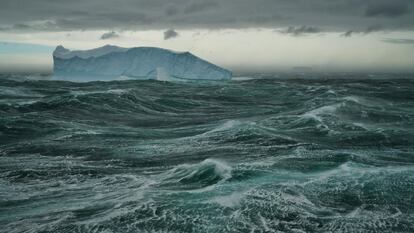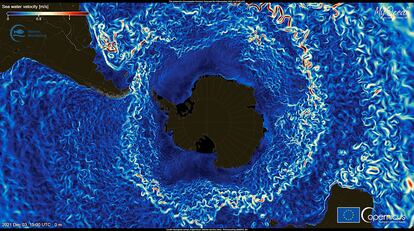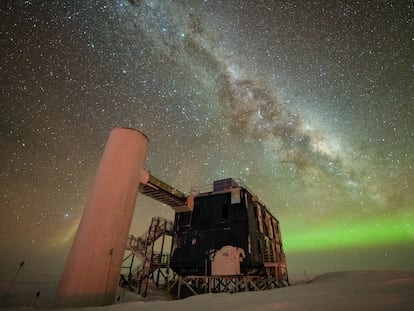The Antarctic Circumpolar Current closed millions of years after the continent froze
Scientists now know when the great engine of global ocean circulation completed its loop, contradicting the theory that the current is responsible for the glaciation of Antarctica

The planet’s main marine current, which today keeps Antarctica thermally isolated from the rest of the planet and protects all the ice the continent houses, closed much later than previously believed. That is the main conclusion of research that studied the fish skeletons and the size of sand grains from the past to affirm that the loop of the Antarctic Circumpolar Current (ACC) was closed 14 million years ago, at the earliest. This immense current of water, the driving force of all ocean circulation, largely determines the global climate and is currently feared to be weakening.
Antarctica was a garden where there were even palm trees until about 34 million years ago. But at that time there was a sharp drop in CO₂ levels in the atmosphere that cooled the entire planet and the Antarctic continent began to accumulate more and more ice. During the last half century it has been maintained that the opening of the so-called Tasmanian Gateway that separated Australia from Antarctica and then the Drake Passage — that separated South America from the new continent now located at the South Pole — opened the way to oceanic waters, which surrounded and isolated Antarctica. The current, whose scientific name is the ACC, became a wall of cold waters that prevented the arrival of warmer waters from the tropics. This is how the largest accumulation of ice on the planet was formed.
For Carlota Escutia, a researcher at the Andalusian Institute of Earth Sciences (CSIC-University of Granada), “it is a very nice explanation, but our work shows that it was not like that.” And it wasn’t because the clues point in another direction. In their research, published in Nature Geoscience, a group of scientists has reached this conclusion after combining the analysis of two types of sediments from two points through which the ACC passes.
One of these tests is the size of sand grains sedimented over millions of years. Escutia explains it: “You have a sediment at the bottom of the ocean and a current moving over it. If it is too loose, it will only be able to drag very fine materials, or perhaps it can’t even drag anything. But as you increase the intensity, the speed of that current will be able to drag much thicker materials. It is the same process that occurs in deserts.”
From the size of the grain of sand they were able to estimate that the transfer of water occurred at a rate of about 10 centimeters per second. That’s half the current pace. That doesn’t fit with the brutal strength exhibited by the current circumpolar current. “Near the surface it is even stronger, with speeds between 25 and 40 centimeters per second,” the senior author of the research explains.

The study’s lead author, Dimitris Evangelinos, was one of Escutia’s students and he has become an expert on the other indicator that the team used to contradict the dominant theory about ACC. The heads and teeth of fish accumulated in the fossil record preserve a certain ratio of two isotopes of the chemical element neodymium. By comparing the fossils from the two points on the seabed, they could find out if the current’s movement had made them uniform. “The ratio between neodymium isotopes that we measured in fish teeth and bones can give us information about the water masses that, in the past, acted in our study area and thus reconstruct the changes in ocean circulation,” he explains.
What the scientists saw is that the current passing through both points was not the same and was much less intense, at least until about 14–12 million years ago. In other words, long after the time in which the ACC was believed to have formed. It is from a time when the speed of the waters at the bottom was accelerating until it approached the current rate and when the neodymium signal is the same between both excavated sites. Everything indicates that it is in that period, and not before, when the flow of waters around Antarctica is completely closed and is similar to the current we have now.
“Today, the ACC is the strongest current in the world and connects all the oceans. This has global implications for the climate on our planet,” recalls Evangelinos, who now works at Imperial College London and the University of Barcelona. One of these implications is that its current configuration results in an enormous flow. Its dimensions almost escape the human scale. It is 23,000 km long, around Antarctica, and it is up to 2,000 km wide. Furthermore, unlike other large currents, it stretches from the surface to the ocean bed. According to data provided by the authors of the study, it transports 100 to 150 million cubic meters of water per second, several times greater than other strongest currents in other oceans (such as the Gulf Stream or Kuroshio Current.) Through Drake Passage, which separates South America from Antarctica, the water flow is 135 million cubic meters per second, which is equivalent to the flow of all the rivers in the world combined.
Such a strong current acts as a barrier, preventing warmer waters from approaching Antarctica, and generating thermal insulation of the continent. This mechanism plays a very important role in preserving the Antarctic ice cap and would explain why the South Pole was escaping the action of global warming. “A much weaker current like the one our data proposes and a lower presence of sea ice allow warmer waters to get closer to Antarctica. This implies a very different oceanographic configuration in the past from what we have today,” Evangelinos maintains.
To put an end to the dominant theory until now, Evangelinos’ and Escutia’s thesis must cover the weakest flank they have. Their current study is based on the analysis of sediments extracted from two ends of the Pacific Ocean, but they lack information about the Atlantic part of the current, the one that receives the waters through the Drake Passage (the ACC runs from west to east, in the same direction as the Earth’s rotation). Evangelinos is now aboard the Hespérides, the Spanish Navy’s oceanographic research vessel. One of his missions will be to recover a sediment tube from the seabed with the teeth and heads of fish from millions of years ago to support his idea that the engine of ocean circulation, and, therefore, of the global climate, was put in motion much later than previously thought.
Sign up for our weekly newsletter to get more English-language news coverage from EL PAÍS USA Edition
Tu suscripción se está usando en otro dispositivo
¿Quieres añadir otro usuario a tu suscripción?
Si continúas leyendo en este dispositivo, no se podrá leer en el otro.
FlechaTu suscripción se está usando en otro dispositivo y solo puedes acceder a EL PAÍS desde un dispositivo a la vez.
Si quieres compartir tu cuenta, cambia tu suscripción a la modalidad Premium, así podrás añadir otro usuario. Cada uno accederá con su propia cuenta de email, lo que os permitirá personalizar vuestra experiencia en EL PAÍS.
¿Tienes una suscripción de empresa? Accede aquí para contratar más cuentas.
En el caso de no saber quién está usando tu cuenta, te recomendamos cambiar tu contraseña aquí.
Si decides continuar compartiendo tu cuenta, este mensaje se mostrará en tu dispositivo y en el de la otra persona que está usando tu cuenta de forma indefinida, afectando a tu experiencia de lectura. Puedes consultar aquí los términos y condiciones de la suscripción digital.
More information
Últimas noticias
Most viewed
- Reinhard Genzel, Nobel laureate in physics: ‘One-minute videos will never give you the truth’
- Oona Chaplin: ‘I told James Cameron that I was living in a treehouse and starting a permaculture project with a friend’
- Pablo Escobar’s hippos: A serious environmental problem, 40 years on
- Chevy Chase, the beloved comedian who was a monster off camera: ‘Not everyone hated him, just the people who’ve worked with him’
- Why we lost the habit of sleeping in two segments and how that changed our sense of time










































